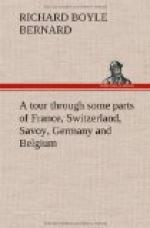I found that the season had long ended at Spa; that the roads were bad, and that it was above thirty miles out of my way, and therefore determined on proceeding to Brussels in the diligence, to make trial of one of the public carriages of this country, having found the posting good from Cologne to Liege. I found it extremely spacious, when compared to those in England, and it was lined with faded yellow damask. I had but two companions, who, according to Rousseau’s Axiom, would not be entitled to the name of men, which, he says, belongs to none under five feet six inches.
They proved, however, sufficiently agreeable companions, and I found they resided at Louvain. We proceeded at the rate of rather more than four English miles an hour, which was quicker than I had before travelled in a public carriage on the continent. Our first stage presented nothing remarkable; but the next, St. Tron, was a remarkably neat little town. There is a spacious square, surrounded with good houses, and at one end is the town-house; the church is a large building, and its steeple contains a set of musical chimes, to which the people of this country are very partial.
We next reached Tirlemont, formerly one of the most considerable cities of Brabant, which is at present by no means of equal importance. The surrounding country is fruitful; many of its villages contain cottages of clay, which I did not expect to see in so opulent a province; they are indeed spacious, and the interior is kept very neat. The general appearance of the people here is much more in their favour than at Liege.
Tirlemont contains manufactures of flannels, stockings, and cloth. The cotton trade, formerly the great staple of the Netherlands, has of late years been greatly on the decline.
* * * * *
CHAP. XVII.
Although the present population of the Netherlands bears no proportion to that which it formerly maintained, yet it is still very considerable, and exceeds that of any country in Europe, Holland only excepted; being 202 persons to each square mile (see ch. xi. for the population of Switzerland, &c.) The decrease in the number of inhabitants in these provinces is chiefly to be attributed to the religious persecutions which compelled thousands of industrious families to emigrate.
This depopulation is very perceptible in many of the cities I passed through, which are capable of containing double their present number of inhabitants, and is nowhere more striking than at Louvain, where the present population does not exceed 25,000, and where formerly there were 4000 manufactories of cloth, which supported 15,000 labourers. This city is surrounded with an ancient wall of brick, which, as well as its numerous towers, presents a half mined appearance. Many of the public buildings of Louvain indicate its former




